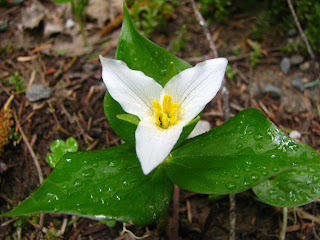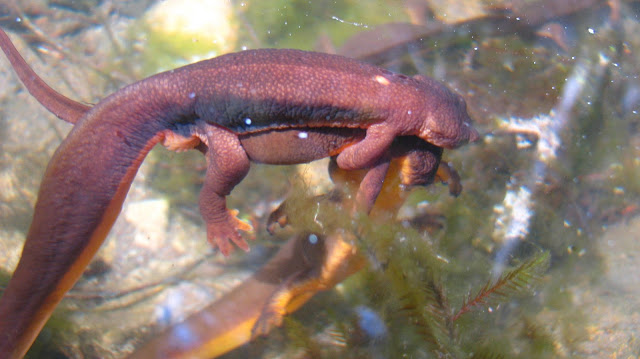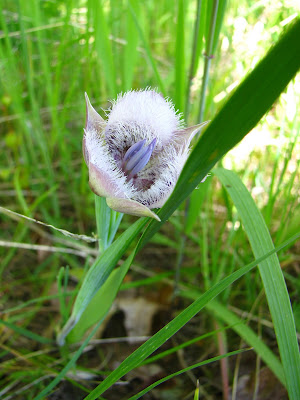 Opal Creek Wilderness is home to some old growth forest. So I went and checked it out. I managed not to get lost (just overshot my turn...) and spent several hours wandering up a trail that leads to Jawbone Flats which was used as a settlement for mining (I think) and now is some sort of wilderness camp program.
Opal Creek Wilderness is home to some old growth forest. So I went and checked it out. I managed not to get lost (just overshot my turn...) and spent several hours wandering up a trail that leads to Jawbone Flats which was used as a settlement for mining (I think) and now is some sort of wilderness camp program. Perhaps by now you are weary of seeing and reading about Trilliums. But just a quick demonstration; to the left one turning pink with age. Above is a little itty bitty Trillium. The end.
Perhaps by now you are weary of seeing and reading about Trilliums. But just a quick demonstration; to the left one turning pink with age. Above is a little itty bitty Trillium. The end.Early into the hike, I came across this girl crossing the path. This is a rough skinned newt (Taricha granulosa), and they are highly toxic. Some idiot in Oregon ate one on a dare once. Can you guess what happened to him? There's also a story about a couple of hikers found dead and no one could understand until it was discovered they accidentally boiled a newt in their tea water. They form a cool co-evolutionary relationship with garter snakes.
Saxifrage (unknown species) that I've seen growing multiple times on rocky outcrops and something in the carrot family being pestered by a small beetle.
There were also more of those sweet little chickweed monkey flowers. And I mentioned this used to be a mining area. Here's an old shaft which is boarded up about ten feet in. Why not just completely cover it...?



More old growth and pretty water works.


Sawmill falls, I think. The lighting made it difficult to capture the whole thing well, but it was beautiful.
 River below the falls. And some more of the right side of the falls. Look how magnificently clear this water is...
River below the falls. And some more of the right side of the falls. Look how magnificently clear this water is...I wanted to jump in fully clothed and guzzle it up. All the water in this park looked so amazingly clear and beautiful.
Ferns unfurling... More crystalline water
Surprise! This bee is actually a fly. Its a bombylid, and a decent enough bee mimic that if you hear it coming you look for the sucker to make sure it won't sting you. The adults are pollinators but the larvae are generally parasitoids. They're so fuzzy!

By far the coolest find of the day were these rough skinned newts. To all of you to whom I yammered about salamanders... These are the ones. And they're actually newts. Considering I'd seen one earlier I ought have put two and two together but... I've never seen these guys in water. And I've seen several.
One of the people I'm now working with had mentioned seeing salamanders (which we now know to be newts), maybe in this park, and so I decided to check out this pool at the edge of the river. And viola, I found upwards of a dozen of the critters wriggling around!
They look pretty neat when they swim. They tuck their legs to the side and propel with their tails. This is a male, he's larger, smoother and has a broader tail. They are toxic, but they are still predated by garter snakes. These newts produce tetradotoxin, a neurotoxin, which can cause paralysis and death. Garter snakes are somehow resistant (something about the protein shape that the toxin usually binds to is different in this snake) to the toxin these newts produce, and are the only known successful predator, meaning they don't die after consuming.
Of course the fun did not end there. Nope. They were mating. There were at least three pairs uhhhh, going at it.
I don't really know the mechanics of it, but the male holds onto the female until she signals him to let go. He then places a spermatophore in front of her which she uses to fertilize her eggs. I guess the clinging thing is a way to tell if he's committed...? Because other males come up during this process and try to butt the lucky guy off. Here are two males fighting over who gets to fight the mating male, then...She looks a little frustrated.
This dude just wants to be left alone.
And in case the photos weren't good enough, have a video!
 Last year when I took entomology and had to make a massive collection, my friend Jenn brought me a Net-wing beetle just like this one in a mint tin. I was touched. I'll also know what net-wing beetles look like for the rest of my life.
Last year when I took entomology and had to make a massive collection, my friend Jenn brought me a Net-wing beetle just like this one in a mint tin. I was touched. I'll also know what net-wing beetles look like for the rest of my life.A quick aside. Sometimes I get reaaaallllly into being accurate on this thing. So if you see anything glaringly wrong, please let me know.
I started my new job yesterday. Although insufficient water was ingested, it was marvelous. We did vegetation surveys in established plots, looking for nectar sources.
 Today we watched the behavior of blue butterflies (Silvery blue and a few Fenders blue) in established plots. I have yet to determine whether I have a reaction to poison oak. I'll let you know if a few days if I begin to balloon up.
Today we watched the behavior of blue butterflies (Silvery blue and a few Fenders blue) in established plots. I have yet to determine whether I have a reaction to poison oak. I'll let you know if a few days if I begin to balloon up.Yesterday we also tented specific plants which in theory will trap newly emerging adults (larval stages feed on the host lupine). So there's a few doz. of these pygmy tents out and about.
Oak prairie. Yes please. This site is at Basket Slough, another refuge in the same complex as the Ankeny NWR.
 Calochortus tolmiei, the Tolmie star-tulip, is a nectar source for Fender's blue butterflies. Also they are very peculiar and beautiful.
Calochortus tolmiei, the Tolmie star-tulip, is a nectar source for Fender's blue butterflies. Also they are very peculiar and beautiful.Not a nectar source, but a red flowering pea whose name I have forgotten. A wild cucumber (Marah oreganus) that also provides nectar. Its all over the place.

Here's a huge oak. Enjoy. The weekend is near!





























Holy cow, those newts are awesome!!! How big are they?
ReplyDelete